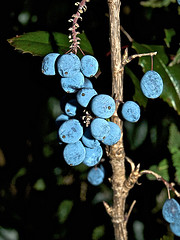Classification
Domain: Eukarya
Kingdom: Plantae
Subkingdom: Tracheobionta
Division:
Magnoliophyta
Class: Magnoliopsida
Subclass: Magnoliidae
Order: Ranunculales
Family: Berberidaceae
Genus: Mahonia Nutt
Species: Mahonia aquifolium
(Pursh) Nutt
The Oregon Grape is put into these categories because it
exhibits all of the following traits.
Domain: Eukarya- Organisms that contain eukaryotic
cells (i.e. nuclear envelope and membrane bound organelles).
Kingdom: Plantae- All
organisms that are multicellular, exhibit alternation of
gernerations, possess a cell wall made out of cellulose, contain
chlorophyll, and are autotrophic via photosynthesis are
considered to be plants.
Subkingdom: Tracheobionta- Any plant that contains
vascular tissue (xylem and phloem).
Superdivision: Spermatophyta- Plants that reproduce
with the production of seeds.

Division: Magnoliophyta- Plants that produce
flowers and seeds that are enclosed in ovarian tissue
(fruit).
Class: Magnoliopsida- Also known as eudicots, or
dicots, which contain two cotyledons, netlike veins, ring
arrangement of vascular tissue, a taproot, pollen with three
openings, and floral organs usually in multiples of four or
five.
Subclass: Magnoliidae- A group of trees or shrubs
that are considered the most primitive of plants remaining
today. Some characteristics are well-developed perianths and
apocarpous ovaries.
Order: Ranunculales- Basal grouping of the
flowering plants, includes herbs, vines, and shrubs.
Family: Berberidaceae- Herbs or shrubs that have
spines or spiny-margined leaves.
Genus: Mahonia- Nutt Genus of barberry shrubs that
have yellow flowers.
Species: Mahonia aquifolium (Pursh) Nutt- Oregon
Grape is a flower that contains evergreen leaves, yellow
flowers, blue berries, and is a well-established flower in
the Pacific Northwest.
Here are two phylogenetic trees to help show how the Oregon Grape is related to other similar organisms.